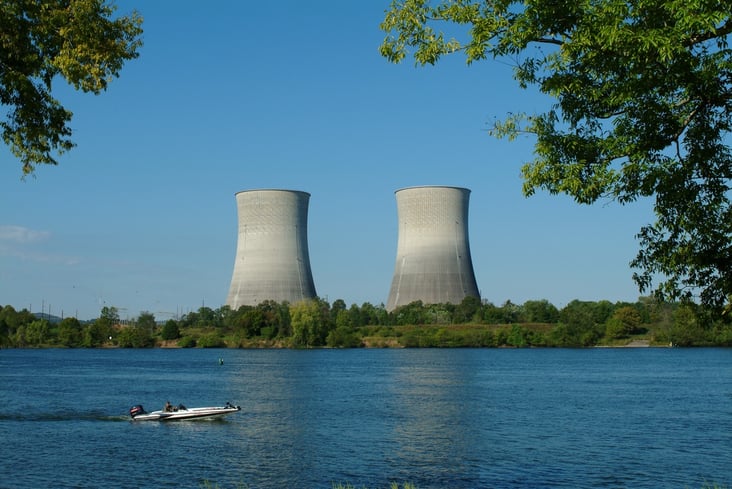
Image courtesy of Tennessee Valley Authority.
Nuclear power generates about one-fifth of all electricity in the United States, but it’s had a rough 40 years or so. Between high upfront costs for installation, complicated permitting, rare but dramatic accidents, and general NIMBY, development of new U.S. nuclear facilities all but halted in the last part of the twentieth century. But that might be changing. In the news this week: new nuclear projects in the Southeast, new nuke-supporting policy in New York, and small modular reactors unveiling some of their secrets. It’s a physics-filled news update from Advanced Energy Perspectives.
The Tennessee Valley Authority is doing final tests on Watts Bar 2, which, when it comes into commercial operation at summer’s end, will be the first new reactor in the United States since Watts Bar 1 came online in 1996. Last week, a major milestone in testing: the Watts Bar 2 reactor reached 75% reactor power, then operators deliberately lowered the generation level to 30%, and then a deliberate and successful shutdown.
Watts Bar unit 2 actually began construction in 1973, with work halted for significant periods in the interim, both for safety concerns and economics. The latest round of construction kicked off again in 2007, and the reactor first came online in May. TVA is cutting no corners. The testing process is slow: ramping up the reactor bit by bit before beginning shut down protocols. Watts Bar 2 also features the FLEX system developed by the nuclear industry in response to Nuclear Regulatory Commission’s Fukushima task force. FLEX involves additional backup power and emergency equipment protecting against a major disruption threatening the cooling system.
In Georgia, more signs of the long-promised nuclear renaissance. As we reported last week, state regulators gave Georgia Power Co. permission to start laying groundwork for a new nuclear facility south of Columbus in rural Stewart County.
Public Service Commission staff had recommended putting off the decision until 2019 but, in light of what the Atlanta Business Chronicle characterized as “growing pressure from the federal government on states to reduce carbon emissions from coal-burning power plants coupled with the volatility of natural gas prices,” the Commission voted to let Georgia Power go ahead with preliminary site work and licensing now.
“If we’re going to close coal plants and add renewables, we have to add more base-load [capacity],” said Commissioner Tim Echols. “It has to be carbon-free nuclear power.”
New York certainly thinks so. Earlier this month the New York PSC approved a clean energy standard of 50% renewable energy by 2030 that includes guaranteed income for nuclear power plants. The subsidies for three aging upstate plants use a formula outlined by Utility Dive as “based on expected power costs and the social price on carbon” federal agencies use. Basically, the PSC has decided to consider the positive externalities of nuclear energy – a reliable energy source that does not produce any emissions or pollutants, including greenhouse gases – at least while renewable energy capacity is built up. This is something that owners of existing nuclear plants, challenged by competition from low-priced natural gas, have been calling for, though mostly to no avail – until now.
Already this policy has borne fruit. Exelon has entered into an agreement to purchase the James A. FitzPatrick nuclear power plant located in Scriba, in upstate New York, which Entergy had planned to retire later this year or early next year if it couldn’t find a buyer. With the PSC’s decision to guarantee the plant’s ability to generate revenue, Exelon was ready to make a deal.
The $110 million price tag may turn out to be a screaming deal for Exelon. The plant does need to be refueled next year, which will cost money, but it’s nothing like the billions usually necessary to start up a nuclear plant. The Watts Bar 2 reactor, for instance, cost $4.7 billion to build, and that’s about half of what similar nuclear plants will cost in Georgia and South Carolina. But with New York’s commitment to keep its nukes going, that $110 million investment could pay off, at least through 2029.
Exelon’s CEO and President Chris Crane sure thinks so. “We are pleased to have reached an agreement for the continued operation of FitzPatrick,” Crane said in a statement. “We look forward to bringing FitzPatrick’s highly-skilled team of professionals into the Exelon Generation nuclear program, and to continue delivering to New York the environmental, economic and grid reliability benefits of this important energy asset.”
On the other end of the nuclear generation scale, small nuclear reactors are continuing to seek a spot in the market. TVA submitted the first-ever permit to locate a small modular reactor (SMR) near the Clinch River earlier this summer. Transatomic, one of the companies offering SMR designs, recently released a white paper detailing the design of their reactor. “This design is the result of years of open, clearly communicated scientific progress,” said Dr. Leslie Dewan, Transatomic’s CEO. “Our research has demonstrated many-fold increases in fuel efficiency over existing technologies, and we’re really excited about the next steps in our development process.”
As Penn State professor Edward Klevans wrote in an Op-Ed for the Pittsburgh Post-Gazette this week, “there is an overwhelming case for continued reliance on, and expansion of, America’s nuclear energy infrastructure.”
Get all the latest news and industry updates by signing up for our weekly newsletter below.
